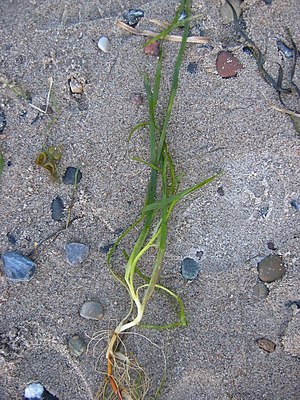Common seaweed
| Common seaweed | ||||||||||||
|---|---|---|---|---|---|---|---|---|---|---|---|---|

Common seaweed washed up on the beach |
||||||||||||
| Systematics | ||||||||||||
|
||||||||||||
| Scientific name | ||||||||||||
| Zostera marina | ||||||||||||
| L. |
The Common eelgrass ( Zostera marina ) is a flowering plant in the family of zosteraceae (Zosteraceae). It grows immersed ( submerged ) to the sea shores of the northern hemisphere , where it forms together with other marine species from the order of plantain-like (Alismatales) underwater seagrass beds , which are important habitats for fish for spawning and other marine animals.
description
The common seagrass grows as an evergreen, perennial herbaceous plant and reaches lengths of 30 to 100 centimeters. It is anchored in the ground with a monopodial rhizome . The foliage leaves have a closed leaf sheath at their base, which does not form small ears. The simple, about 3 to 9 mm wide leaf blade has three to seven parallel nerves and a rounded tip.
The flowers are arranged in two rows on either side of a flattened spike axis (the spadix ) and are enclosed in a flower sheath (the spathe ) at flowering time . The stem of the spathe is somewhat widened above. Each individual flower contains both a stamen and a carpel . The common seagrass forms nut fruits that are cylindrical in shape and have a two-column style at the tip. Their pollen is thread-like.
The chromosome number of the species is 2n = 12.
Occurrence

It grows submerged in the coastal waters of the North and Baltic Seas and the oceans near the mainland; there it occurs to a depth of 10 m, occasionally up to 17 m. It is distributed throughout the northern hemisphere in the temperate and subtropical zones. In places, however, its distribution is decreasing due to anthropogenic influences. That is why it is classified as endangered in the Red List of Endangered Ferns and Flowering Plants in Germany (hazard category 3). It is a character species of the Zosteretum marinae.
Ecology and pollination biology
Since the 1930s, a decline in the structure-forming seagrass meadows of Zostera marina has been observed in Northern Europe and especially on the German North and Baltic Sea coasts . The severe seagrass mortality observed in the North Sea in recent years cannot be explained by the known fluctuations in the population of seagrass species. In addition to infestation by parasitic fungi ( Labyrinthulomycetes ), anthropogenic causes such as water pollution are suspected to be triggers . Seagrass meadows are particularly valuable ecologically, as they offer protection for numerous animal species. So provide seagrass stocks z. B. are often important spawning grounds for fish.
Common seaweed blooms between June and September. The flowers are pollinated only submerged. The individual flowers form a thread-like pollen that is only spread through the water. If small nut fruits have formed, these are also spread through the water. It has also often been observed that certain birds or fish eat the fruit and contribute to the spread by excreting the exposed seeds.
Individual evidence
- ↑ a b Erich Oberdorfer : Plant-sociological excursion flora for Germany and neighboring areas . 8th edition. Page 107. Stuttgart, Verlag Eugen Ulmer, 2001. ISBN 3-8001-3131-5
- ↑ Rafaël Govaerts (ed.): Zostera marina. In: World Checklist of Selected Plant Families (WCSP) - The Board of Trustees of the Royal Botanic Gardens, Kew . Retrieved August 17, 2016.
- ↑ Thomas Meyer & Stefan Nehring: Planting of sea grass meadows (Zostera marina L.) as an internal measure for the restoration of the Baltic Sea. Rostock Marine Biological Contributions, Issue 15, 105–119, 2006, PDF , accessed on May 10, 2017
- ↑ according to Flora Web [1] , accessed on May 10, 2017
Web links
- Common seaweed. In: FloraWeb.de.
- Common seaweed . In: BiolFlor, the database of biological-ecological characteristics of the flora of Germany.
- Distribution in the Netherlands [2] (Dutch)
- Distribution in the northern hemisphere according to Eric Hultén [3]
- Thomas Meyer: Data sheet with identification key and photos at Flora-de: Flora von Deutschland (old name of the website: Flowers in Swabia )